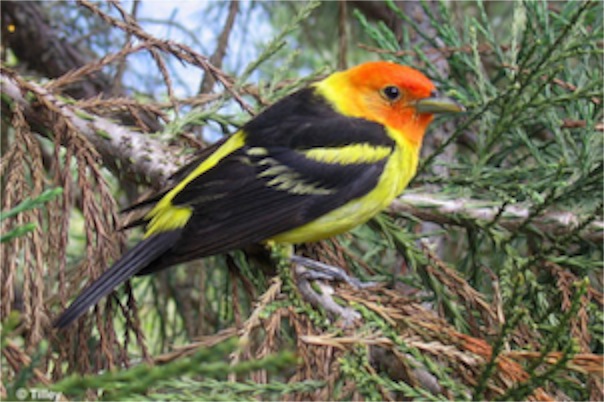Singing a New Song
05/10/12 05:27

Birdcalls are even more complex than the variation between different species of birds, though. The scarlet tanager, one of my favorites, has a different call in the East, where woods are denser than they do out where we live. Scientists have observed that birds in San Francisco have raised the pitch of their songs over the past 40 years of observation. Birdsongs can be more easily heard over the traffic now than was the case when observations were first begun.
The context in which a bird finds itself is a factor in the nature of its song.
I think that this is not just true of birds. It is true of us as well. We behave (and probably sound) differently in different contexts. I know that I am that way. When I am in a new situation that is unfamiliar, I tend to be quiet and reflective. I try to listen very carefully and speak infrequently. As I become more familiar with a setting, I share my opinions more freely and speak more often. I suspect that some people, who do not know me very well, have found me to be quiet and even a bit shy. Others would find that description to be foreign and inaccurate.
Adaptability is one of the great qualities of the natural world. Plants and animals change to respond to the realities of their context. If this were not the case, many would not survive changes in the environment.
It may have always been true, but the time in which we find ourselves seems to particularly call for adaptability in the structures of the church. The way that churches organized themselves, budgeted their resources and provided for leadership in the past will not work in the current environment. Churches that insist on doing things “the way we’ve always done them,” are headed toward decline – maybe even towards extinction.
The change is exciting and keeps those of us who work in the church engaged and learning. We know that recruiting volunteers is different than it was when we began our careers. We know that the shift from programs to events is irreversible and that the coming and going of participants is inevitable. We are learning to live with intense schedule competition and over-committed families. The world is simply different than it was when I began to serve as a pastor.

Those of us who are living out our lives in the midst of the established institutional church are not, however, stuck in the same place. Sure there is the tendency of an institution to stay the course and resist change. There is a nostalgia that can sometimes get in the way as people attempt the impossible task of recovering some of the things from their past. It is a hard lesson for some folks to learn that the reason our churches were full in the 1960’s and 1970’s was the product of sociology, not best practices. Returning to the programs of those decades does not result in returning to the numbers of those decades. But there is a voice or two advocating for such a return in almost every generation of church leaders.
The writer of Hebrews declares, “Jesus Christ is the same yesterday, today, and forever.” The same is not true of the church. The church is constantly changing and evolving as circumstances change. Like the birds, our song needs to be different in different contexts.
Ross Snyder wrote, “We will walk with a truth that is ever before and sing the Lord’s song in an ever-strange land.” The pursuit of the truth of God leads people into new contexts and situations. It leads congregations into new patterns of organization and new ways of doing their work.
As our congregation prepares for a Mission Festival on Sunday, I have been deeply aware of how mission has evolved in the last couple of decades. It was not long ago that we thought of mission primarily as a series of programs that were set by national and international leaders of the church. We would receive news of outreach programs and projects from other settings of the church, often accompanied by slick brochures and full-color bulletin inserts. Our congregation would respond with generosity to appeals. These days, the larger part of our mission consists of projects that arise from the congregation. Many of our mission projects started with an individual coming to church leaders and asking, “what if . . .?”
I am confident that there are new songs yet to be heard from the Church of Jesus Christ. These are exciting times to be a part of the process.